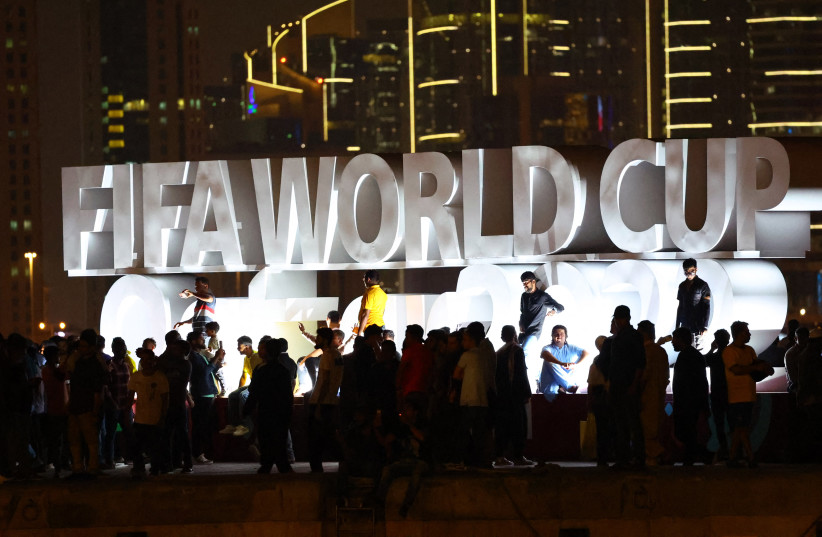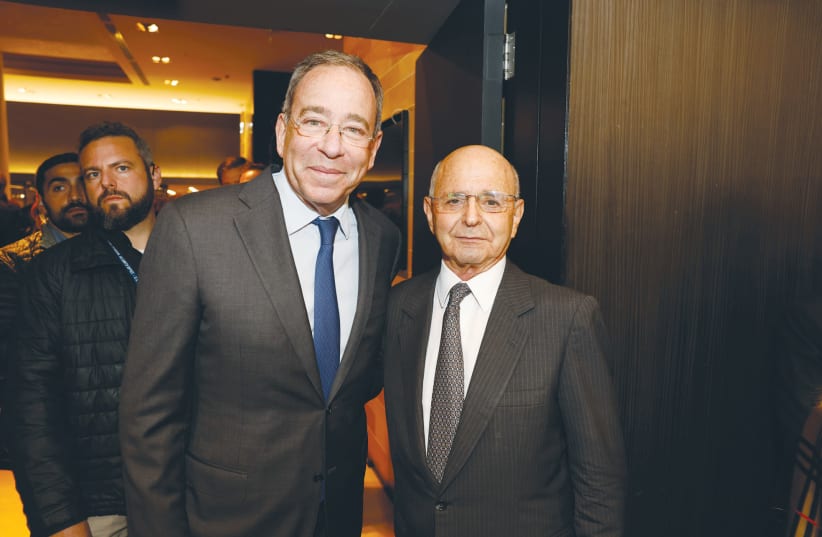Although he is officially the head of the Liaison Office of the Kingdom of Morocco in Israel, Abderrahim Beyyoudh is referred to as ambassador and treated as such not only by the Moroccan community in Israel but also by diplomatic colleagues and just about everyone else with whom he comes into contact.
This week, together with colleagues from Egypt, Jordan, Bahrain and the United Arab Emirates, he was invited by chef Guy Peretz of the Greek Salon taverna in Tel Aviv to come and watch the broadcast of the match between Morocco and Spain in the World Cup series being played in Qatar.
While they were all hoping for a Moroccan win, expectations were not particularly high, so one can imagine the euphoria following Morocco’s mind-blowing triumph as the first-ever Arab country to reach the quarter-finals. As thrilled as they all were, they did not allow the excitement to interfere with their appetites, and happily consumed the victory meal which Peretz prepared for them.

In addition to specializing in Greek cuisine, the Greek salon also has nightly performances of Greek music and song.
Turkey's Jewish history
■ WHEN THE Jews were expelled from Spain and Portugal more than half a millennium ago, many found a haven in Turkey, and today there are Jews in Turkey who can trace generations of their lineage to the period of the Spanish Inquisition. In Turkey, their ancestors set up Jewish community infrastructures including synagogues, some of which are still standing.
Next week, the Embassy of the Republic of Turkiye (as it is known now), together with the Turkiye Promotion and Development Agency and Turkish Airlines will open a photo exhibition of Turkish synagogues by acclaimed Turkish photographer Izzet Keribar. The exhibition, which commemorates the 530th anniversary of the Sephardic Exodus to the Ottoman Empire, will be held at the Saraya Turkish Cultural Center in Yosef Carmel Square, Yafo, just a few steps from the clock tower. It will be open to the public for at least two months.
A philanthropically minded art meeting Bank Hapoalim
■ ON THE subject of exhibitions, Ruben Krupik, chairman of the board of directors of Bank Hapoalim and Dov Kotler CEO of the bank will on Friday morning, December 23, be meeting philanthropically minded art lovers at the Bank Hapoalim building at 63 Yehuda Halevi Street, Tel Aviv, where the bank holds an annual exhibition and sale of Israeli art.
The exhibition is always well attended and the proceeds of sales go to three leading organizations that support youth at risk and to the artists themselves. The exhibition includes works by several of Israel’s leading artists.
Recognize Jews who saved Jews in the Holocaust
■ FOR MANY years, Yad Vashem refused to recognize the heroism of Jews who saved other Jews during the Holocaust. Its researchers went to great pains to investigate the acts of non-Jews who had been recommended for the title of Righteous among the Nations, and indeed found sufficient evidence to indicate that tens of thousands of people were indisputably deserving of the title.
The attitude was that non-Jews owed nothing to Jews and if they put themselves at risk in their efforts to rescue Jews from the clutches of the Nazis, they deserved recognition. It was somehow taken for granted that Jews would save other Jews and therefore did not require recognition. The offspring of such heroes thought differently and for years waged a fruitless struggle to have close relatives recognized for their heroic and humanitarian deeds.
The B’nai B’rith World Center – Jerusalem also believed that Jewish heroism in the Holocaust should be publicly recognized and instituted an annual ceremony whereby living heroes are recognized by the ambassadors of their countries of origin. If the heroes are no longer living citations for heroism are given to their children or grandchildren or both.
This year’s ceremony will be held at Kibbutz Hazorea on Tuesday, December 13. Honorees will be members of a Zionist youth group in Hungary that formed an underground resistance and rescue movement during the Holocaust through which they were able to save the lives of 45,000 Jews.
It goes without saying that Hungarian ambassador Levente Benko will be in attendance along with officials from the B’nai B’rith World Center and various other organizations involved in Holocaust research and in Zionist activities in Hungary. Three of the heroes who are still living will be present and their stories will be told. Others not living will be represented by their children and grandchildren.
What some 200 young people did at great personal risk is almost beyond belief and would make for a highly dramatic film. Strangely, the story of that valiant, widespread rescue mission is virtually unknown. Even the families of the rescuers did not know the story and learned part of it only in recent years.
The three living members of the Zionist underground youth movement are now aged 97 and have been happily rewarded by raising families of their own. David Gur of Ramat Gan is the father of three, grandfather of 10 and great-grandfather of eight. Sarah Epstein of Kibbutz Givat Brenner is the mother of three, grandmother of nine and great-grandmother of 24. Dezi Heffner of Kibbutz Negba is the mother of four, grandmother of eight and great-grandmother of 11.
The ceremony will be recorded and will also be broadcast live.
Marking the anniversary of Nazi genocide against Jews in Latvia
■ IF TRUTH be told, no distinction should be made between Jewish and non-Jewish heroes of the Holocaust. There are good-hearted and courageous people of every faith who are guided by their belief in humanity and their abhorrence of evil.
Last week, the Association of Latvian and Estonian Jews in Israel, which is chaired by Elie Valk, marked the 81st anniversary of the first genocidal action by the Nazis and their collaborators against the Jews in the Rumbala Forest near Riga, the capital of Latvia. The Association has been commemorating this event for seventy years and this year decided to honor the righteous among the nations who put their lives and those of their families at risk in order to save Jews.
Honored among the rescuers were Robert and Johanna Sedols, Otilia Shimelpfenig and Karlis Vestens who saved Ada Israeli, nee Zivcon and several other Jews; Ulita Vasrushkina who saved Mikhail Varushkin (Tager); Fridrich Kumerov who saved Aviva Niburg Braver; Emils Resnais, who saved Ina Frtidman Mihelson; Karola Rudzite nee von Lndenkamph who saved Inna Volpert Hait and Zhanis Lipke who saved three members of the Vagenhaim family – Yaakov, Lev and Max, who are no longer living. Among the people in attendance was staff sergeant Ron Yaakov Vagenhaim, the great-grandson of Max.
For many Holocaust survivors, whether living or dead, their great triumph has been to have their children, grandchildren and great-grandchildren serve in the Israel Defense Forces.
The stories of the rescuers and the rescued were told and memorial candles were lit. Soon there will be no one left who can tell either side of the story, which is why it is so important that so many stories of the ingenuity employed by rescuers in hiding and feeding Jews in their homes or in nearby churches, mosques and forests, smuggling them out of ghettos and even out of concentration camps, and providing them with false papers have been and must be documented in oral and written testimonies as a legacy for future generations.
The Dan chain hotels
■ AT ONE stage or another, every president of Israel since Yitzhak Ben Zvi, every prime minister, every government minister and most members of Knesset have set foot in one or more of the Dan chain hotels, which were founded by brothers Yekutiel and Samuel Federmann, after purchasing the Dan Tel Aviv, the first of the hotels in the chain. Although the King David hotel in Jerusalem is the company’s flagship hotel, the Federmann family, in celebrating the 75th anniversary of the chain, decided to do so in the venue of the chain’s inception.
Last Tuesday, they hosted a reception for some 500 people among who were outgoing Tourism Minister Yoel Razvozov former prime minister Ehud Barak and his wife Nili, former foreign minister Sylvan Shalom, along with many hoteliers, past and present legislators, diplomats and leaders of Israel’s business community including US Ambassador Tom Nides, Bank Leumi chairman Dr. Samer Haj Yehia; hotelier and real estate magnate Alfred Akirov and his wife Hava, David Fattal, the head of the Fattal Hotels Group, Lior Raviv, the CEO of Isrotel, Bank Hapoalim CEO Dov Kotler; Gideon Hamburger, the president of Harel Insurance and many other well-known personalities too numerous to mention.
President Isaac Herzog sent a video greeting and invitees later viewed another video that presented the history of the chain, highlighting some of its famous guests.
The mysterious advertisement? It's the Histadrut!
■ IF YOU wondered who is behind the large dramatic advertisement with the single word ‘Enough’ in white with a blue exclamation mark on a black background, it’s the Histadrut, the Federation of Labor, which is chaired by Arnon Bar David. Its name appears in red in very small letters in advertisements in the Hebrew press, but not in those published in The Jerusalem Post.
The advertisement was designed by the prestige British multinational advertising and communications agency Saatchi & Saatchi with a network of 114 offices in 76 countries and a combined staff of more than 6,500 people. In addition to dealing with the Pratt & Whitney crisis, which is costing hundreds of Israelis their jobs and their income, the Histadrut is battling Israel’s high cost of living that makes day-to-day existence a constant struggle for people on a basic wage, for pensioners who have no other income, for parents who both have to work to support their families and more.
The Histadrut wants to lower the cost of living, raise the minimum wage, increase old age pensions and freeze the cost of electricity. This is not a political fight, it insists. The cost of living has nothing to do with the Left or Right. It is a social struggle that must lead to a revolution.
greerfc@gmail.com
